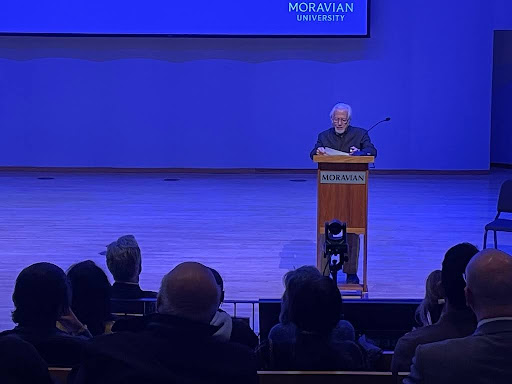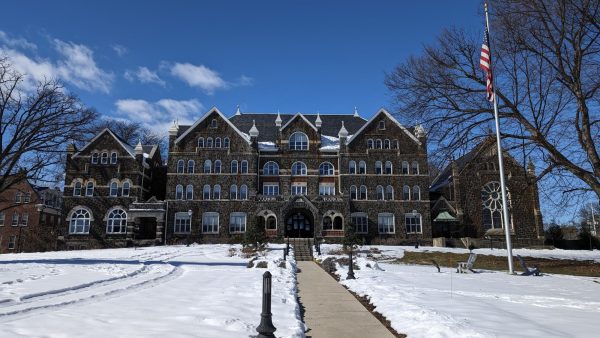Author Eric Rutkow Finds U.S. History in Our Trees
Eric Rutkow, author of the historical book American Canopy, visited Moravian College on an unseasonably warm fall evening of October 18 to discuss the history and production of forestry and tree-harvesting techniques in the United States from the mid-1800s to present day.
Rutkow’s presentation in Prosser Auditorium caught the attention of some Environmental Science majors, as well as other professors and students interested not only in the subject of forestry but the significance of forest management and the sustainable harvesting of trees, an important topic for Moravian College’s In-Focus theme this year on sustainability and the environment.
Rutkow’s presentation, titled “The Great Shift: How Trees Became a Renewable Resource,” addressed the history of the “dense, diverse, and wide-spreading American Canopy,” in addition to the sustainable efforts by foresters and the American government in the 20th century to rebuild the estimated one billion acres of native forest lost over two centuries of deforestation.
The history of harvesting American trees as a crop source is a rocky one, to say the least, beginning with a man named Frederick Weyerhaeuser, who promoted the concept of timber warehousing in the United States. A tremendously wealthy forester, Weyerhaeuser began mining the white pine for his newfound Mississippi River Logging Company in the mid-1800s.
Thus began the problematic over-harvesting of forests (specifically of white pine and Douglas fir ) across the U.S. Subsequently, one of the largest river courses for timber transportation was established in the Midwest, and log jams along the river were a common threat to the production of lumber trade. Railway transportation eventually took the place of river courses for lumber transportation, and, shortly after the expansion of lumber trade, Weyerhaeuser went westward to purchase over 900,000 acres of forest land from a railroad company in order to harvest Douglas fir, among other trees.
In 1864, author George Perkins Marsh of the book Man and Nature proposed a newfound concept towards sustainability in order to protect American forests from deforestation.
Marsh realized at the time that “man alone is to be regarded centrally as a destructive force,” after recognizing that “the earth is no longer fit for the habitation of man” by cause of rapid deforestation.
Marsh’s principal concepts on the manmade destruction of the environment inspired, the soon-to-be politician and president Franklin Delano Roosevelt to take action locally in his hometown of Hyde Park, New York, which contributed to the establishment of the National Forest Service in 1905 to regulate and protect the nation’s forests.
Along with the government’s movement to protect national forests, Pennsylvania forester Gifford Pinchot also initiated the movement towards sustainable forestry by recognizing the value of trees as a crop source meant to be farmed specifically for harvesting. The push for sustainable forestry by the government and American foresters led to the growing of trees as a renewable resource, and not as a natural source to be mined and harvested.
By the mid-20th century, tree farms were established across the United States, and reforestation efforts were made by major lumber producing companies, such as Bogalusa, Louisiana’s man-made tree farm, which re-planted over 2,000 acres of trees.
Roosevelt recognized the economic importance of tree planting “as a key to the nation’s future.” Non-industrial tree farms became certified for ethical harvesting practices, and the concept of producing man-made forests as a means to maintain sustainable forest health has been an ongoing practice into the 21st century.
The goal of Rutkow’s presentation was to change how we as a society view American forests. Rutkow believes that, “We have some of the best forest resources than anywhere else in the world,” which is why it is important to recognize the value of trees as a renewable crop source, and not as an irreplaceable source for mining and harvesting.
Rutkow’s book American Canopy further details the fundamental significance of American forests throughout the nation’s history.












